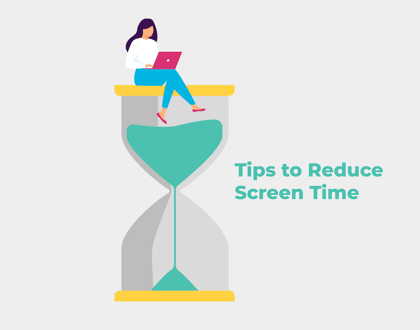 If you’re working from home these days, chances are you’re connected to more than one digital device.
If you’re working from home these days, chances are you’re connected to more than one digital device.
When you log off for the day, it’s unlikely you detach from all your devices in fear of missing an important notification. Given that most adults spend at least three hours daily on their phones, it’s not improbable that most of us spend a majority of the day looking at screens.
If you’ve been looking at ways to learn how to reduce your screen time, just know it is possible!
Even if you wouldn’t say you’re “addicted” to your devices, you might find it helpful to cut back. Research proves that too much time on screens isn’t good for overall mental or physical health. In fact, a The Journal of Social and Clinical Psychology study published in 2018 found a link between using certain social media apps and "decreased well-being."
Additionally, too much screen time can lead to:
-
- Anxiety
- Obesity
- Eyestrain
- Headaches
- Bad posture
- Chronic neck and shoulder pain
Ready to start reducing your screen time and start enjoying more “real life” time instead?
This post will look at reasons to cut your screen time down and how to reduce screen time with ease:
How Much Screen Time is Too Much?
While Mayo Clinic recommends no more than two hours daily for adults, that’s not quite practical for those who work on computers daily. What you can do, however, is limit the amount of mindless time spent on devices after work. Not only will it give your mind a break, but it’s also better for your health, too.
Plus, being too “plugged in” all the time can lead to tech addiction. If you find yourself unable to control your need to be online 24/7, it may be time to set boundaries around your tech time.
Healthy screen time tip: Track your time spent on screens both inside and out of work. Note any physical and emotional symptoms you feel on those days as well. See how it may correlate to your activity online or time spent in front of a digital device. Then, look at ways to cut back — even if it’s just 15 minutes daily.
How Much Screen Time Are You Getting?
You may not realize how much time you spend on your devices. Between work, remote school, social media, online businesses, banking, and more, it’s nearly impossible to have zero screen time each day.
If you haven’t discovered it already, most smart devices have a setting where you can track your screen time usage. This can be particularly helpful if it seems you are running out of time each day to do projects that are important to you. You can see how much time you spend on social media, browsing, online shopping, etc., and then make a conscious decision to change your habits.
Mostly spending your time on a computer? You can track your screen time activities with various apps or manually track it with a free service like Toggl. When you start and stop the Toggl timer, it helps you consciously see the digital spending you’re doing.
Easy Tips for How to Reduce Screen Time
If you’re willing to stay committed to it, you can learn how to reduce your screen time. It may mean you pick up a book instead or go outside for a walk. With practice, you’ll find healthier ways to spend precious time. Your eyes, fingers, and body will thank you for giving it a rest!
Here is a look at some ways to minimize screen time:
Take Your Scheduled Breaks
If you work at a computer all day, you know how tiring it can be. It can cause eyestrain and back pain, along with headaches, too. Make it a point to set a timer and schedule breaks to get up and stretch. You can even just look away from the computer and do some eye exercises to give yourself a break, too!
Find an Accountability Partner
When you’re constantly on your digital devices, it’s easy to miss out on opportunities to play and connect with others — two activities that are essential to relaxation! If you’re having a hard time ditching the phone habit, consider asking your partner, best friend, or even a coworker to hold you accountable. This works best if you can find someone who also struggles with too much screen time. Together, create a list of how to reduce screen time for an easy reference during times you’re tempted to pick up the phone. Write it down and cross off any activities listed that you do instead of using your devices.
Schedule No Device Times
This can be especially helpful when you have young ones in the house. Mayo Clinic advises kids ages 2-12 to get less than an hour daily of screen time. Consider taking a full day off from all devices on a weekend day and spending time together outdoors, for example.
Charge Your Devices Elsewhere
If you keep your phone or tablet on or near you at all times, you may not even notice the invisible tether that’s keeping you connected to your gadgets. Unless you need to keep your devices near you because you’re on-call for work, consider keeping your bedroom off-limits for screen time. Charge your digital devices in another room to keep the temptation to check emails in the middle of the night away.
Try Website Blockers
If you’re guilty of bouncing around from your inbox to your work projects and everything in-between, you may want to look at website blockers. Block distracting websites and apps with services like Serene or Cold Turkey to help you stay laser-focused on the most important tasks at hand.
Go Back to Pen and Paper
As tempting as it is to dash off quick messages via Slack channels or email, make it a point to get up and go see coworkers in-person about requests. You won’t want to do this for everything, but get your steps in and bring your notebook to jot down notes instead of keeping it all online. Bring a notepad to meetings, too. To-do lists? Same thing. Sometimes simple is best.
Reducing Phone Screen Time
If your phone is your biggest screen time downfall, you’re not alone. One recent study of 11,000 people found most people spend over three hours daily on their phones. Between the notification alerts and the temptation to scroll mindlessly on social media, it can be hard to put those little pocket computers down.
Feeling guilty when you get your average screen time report each day? It may be time to take a mindful approach to how you can minimize your phone screen time.
Here’s how to do it:
Delete Distracting Apps
It’s easy to go down the “scroll hole” on social media apps like Facebook, Twitter, Pinterest, and TikTok. Even professional sites like LinkedIn can be time-wasters. Look at your most-used apps and see if you can get by with deleting them off your phone. Or, move them off your home screen so you’re less tempted to use them. You can also set up time limits on some smart devices, too, so you don’t exceed a set amount of time each week.
Leave Your Phone in Another Room
When you’re working from home, it can be a lot easier to check your phone much more than if you were in the office with your boss nearby. When you have to do focused periods of work, consider keeping your phone in the other room. Watch your productivity soar and your temptation to distract yourself disappear with each day you do it.
Don’t Get in Bed With Tech
Phones emit a blue light, which can restrict your body’s ability to release melatonin, a hormone needed to help you fall asleep. Plus, scrolling on Facebook or reading the news just before bed or first thing in the morning can cause your anxiety to spike. Keep your phone out of sight to charge in another room. It may make it easier if you decide a specific time to cut off phone use in the evenings, too.
Ask People to Call You
How much faster could you get conversations wrapped up if you just picked up the phone and called someone? Save your thumbs and fingers from cramping and ask people to call instead of text. Sometimes it’s nice to hear a loved one’s voice on the other end of the phone, too!
Reduce Screen Time and Enjoy More of Life’s Moments
How can you start reducing the time spent in front of screens?
You may have to get a little creative, but it’s possible to eliminate unnecessary screen time. Not only can it improve your physical health, it will likely help your mental health, too. Whether you stop eating lunch in front of the computer or keep your phone out of sight during meals, all those minutes add up to less screen time.
With these tips, you should be able to at least minimize the amount of distracting buzzes, notifications, and online social “obligations” vying for your attention.
When you’re able to nix that extra screen time, take a moment to consider how you’re fully enjoying the present moment. It makes it a lot easier to catch life’s special opportunities when you aren’t distracted by technology.
Go give it a try! Even if it’s starting with device-free zones or full weekends, take note of how you feel and how you’re better able to enjoy yourself without being tethered to tech.
How do you limit your screen time? Which apps or websites do you have the hardest time limiting your time on? Let us know in the comments below!



